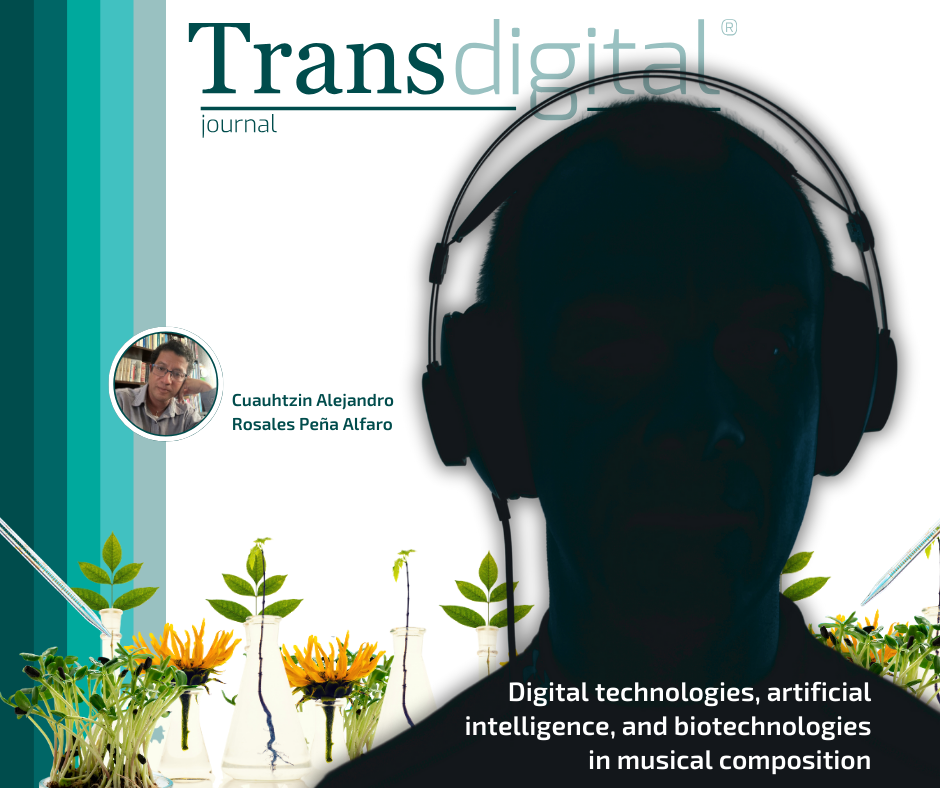Digital technologies, artificial intelligence, and biotechnologies in musical composition
DOI:
https://doi.org/10.56162/transdigital212Keywords:
music, contemporary art, artificial intelligence, algorithms, biotechnologyAbstract
Technologies have been a constant in the development of musical composition and contemporary art, so it is obvious that new digital advances are incorporated into artistic and musical production. From conventional computations, more complex algorithms that favor artificial intelligence, to the use of biotechnologies and unconventional computations, composers and artists have used different tools to create works in keeping with the times and innovations in which we live. This essay has as starting point the study in which computational technologies (conventional and unconventional), artificial intelligence (AI) and biological technologies are incorporated into the field of musical composition from the use of probabilistic algorithms, autogenerative language and models of learning, as well as the insertion of biological technologies and living organisms to produce music or other hybrid art forms. The use of many of these artistic-technological-musical supports is, in fact, territory that musicians continue to explore, which is why it is intended to support research on this topic. The main aim is to open the discussion on how music makes technologies apparently foreign to it its own, as tools that contribute to artistic production, making them part of its poetics and discourse. In addition, the way in which life, nature and even the environment are reflected on, based on art and music as innovative and creative proposals.
References
Fubini, E. (2005). La estética musical desde la Antigüedad hasta el siglo XX. Alianza Editorial.
García, L. (s.f.). Portafolios. https://lessnullvoid.cc/content/portfolio/
Hewett, I. (2010). A music beyond time. En I. Hewett, C. Lovelace, S. Kanach, M. Xenakis (Ed.) Iannis Xenakis: Composer, architect, visionary. (pp. 17-33). The Draw Center.
Hiller, L., Isaacson L. (1959). Experimental music. Composition with an electronic computer. McGraw-Hill.
Juanes, J. (2010). Territorios del arte contemporáneo. Ítaca.
Lovelace, C. (2010). How do you draw a sound? En I. Hewett, C. Lovelace, S. Kanach, M. Xenakis (Ed.) Iannis Xenakis: Composer, architect, visionary. (pp. 35-94). The Draw Center.
Miranda, E. (2014). Harnessing the intelligence of physarum polycephalum for unconventional computing-aided musical composition. International Journal of Unconventional Computing, 10(3), 251–268.
Miranda, E., Braund, E., Venkatesh S. (2018). Composing with biomemristors: Is biocomputing the new technology of computer music? Computer Music Journal 42(3), 28-46. https://doi.org/10.1162/comj_a_00469
Taruskin, R. (s.f. a). . Oxford University Press, Music in the Late Twentieth Century. Oxford University Press https://www.oxfordwesternmusic.com/view/Volume5/actrade-9780195384857-chapter-002.xml
Taruskin, R. (s.f. b). Chapter 10 Millennium's End. Oxford University Press, Music in the Late Twentieth Century. Oxford University Press. https://www.oxfordwesternmusic.com/view/Volume5/actrade-9780195384857-chapter-010.xml

Downloads
Autor de correspondencia
El autor de correspodencia se identifica con el siguiente símbolo: *Published
How to Cite
License
Copyright (c) 2023 Cuauhtzin Alejandro Rosales Peña Alfaro

This work is licensed under a Creative Commons Attribution 4.0 International License.
All articles in Transdigital are licensed under a Creative Commons Attribution 4.0 International License. Authors hold the copyright and retain publishing rights without restrictions.









